Washington Part 2
Monday 5th January
We planned to go to the Capitol Building, as we expected that being a Monday there would be less tourists. We arrived at the ticket line (like the Washington Monument - free tickets, but only available on the day of the tour) before 9am, and just before a bus load of tourists, so we were in the first tour - which was good, as it was just starting to rain as we started. Did the usual security thing, but were warned that we couldn't take any bottled water in. We ended up emtying our SA Water bottle on the grass leading up to the security entrance, and having to explain to the security screeners, that it was a 'special' water bottle - otherwise, they would have thrown it away! We had an excellent tour guide - knew so much about the history, art work, contruction of the building, who had been where, and who had done what. The speech was quite practiced, so not much spontinaity.
It is quite a large building - built in stages, with the wings added when the House and Senate outgrew their chambers, and the dome being increased in size.
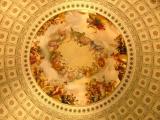
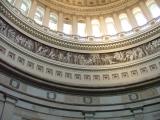
The interior is beautiful - no expense spared - more like a palace than a government building. The dome seen from the outside is a different size to the one seen inside - the original was built and painted inside, and the then outside was extended. The tour started in the room below the dome - The Rotunda. In this room, there is a freize depicting the history of the USA - completed by a different artist to the one who started it, due to the original dying partway through the project. The inside of the dome contains a painting called "The Apotheosis of Washington". This painting depicts George Washington surrounded by symbols of American democracy and technological progress.
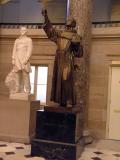
The tour continued to the original Hall of the House chamber - this had acoustic problems, as well as seating problems and was not generally liked by those who used it. It has a half-dome roof, which helps in some ways, but as the floor is marble, the echoes were many. This was renamed as the National Statuary Hall, which contains (along with other areas throughout the building) two statues of its notable citizens from each state. Some states have replaced their statues with new ones depending on the people they wish to honour.
We then saw the Old Senate Chamber, and the old Supreme Court (used before the current Supreme Court Building was built). The Supreme Court was quite small, and somewhat "in the basement". The tour finished in the visitor center where there were displays showing the construction of the building and telling of its history.
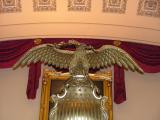
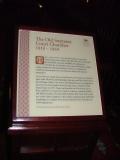
Our guide said we should go across the road to see our state Congress(wo)man to get a ticket to see the House of Representatives where the President gives his annual address. Foreign nationals were instructed to take their passports to somewhere else to get a ticket. As we didn't have passports and have CA drivers licenses but are not citizens, we asked the guide where we shoud go - she pulled tickets from her pocket (she had a wad of them) and gave two to us. So we went and had a look - it was not as meaningful as seeing the House of Reps/Senate Chambers in Canberra - more of a "seen that, next?". They're building a new visitor's center underneath the eastern side of the Capitol Building - they have dug a huge hole in the ground at the front of the building, and construction is due to be completed in 2005. It is costing something like $1 billion which is extraordinary.
It was interesting to compare the Capitol Building to the Australian Parliament House - the Capitol seemed to be trying to replicate the grand buildings of Europe, including art, sculpture, and is not built to reflect anything particularly "American", whereas the Australian Parliament House intentionally represents native timbers, Aboriginal designs, the symbology of the grassed areas on top of the house. The eras in which they were built also play a part in this.
Next was the Supreme Court building across the road - we entered and queued for a tour/lecture. The foyer of the building was huge and included a Christmas tree. There were huge marble columns and an amazing ceiling (see photo). The lecture was given by an intern. She told us about its construction - money was appropriated (ie given by congress) before the depression. The building was done during the depression, and hence came under budget, so they hired artists to paint and beautify the building. They still had money left over, so they added gold to some of the ceilings. They still had excess money, so they gave it back to congress. Seeing the US Supreme Court made us want to visit the Australian High Court in Canberra - something we hadn't done whilst living there.
At lunch we took the advice of one of the Capitol building guides - there is a food court/canteen in the Government building complex across the road from the Capitol, and we joined hundreds of government workers for an inexpensive lunch.
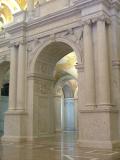
The Library of Congress was started when Thomas Jefferson donated his collection of books to start the library. It has somehow survived fire (where most of the books were burnt) to become the largest library in the world. This is in no small part due to the copyright act which requires all items copywritten to be submitted to the Library of Congress. We arrived in time for a tour, given by a retired lawyer, and he was excellent. He took us all over the building showing us the enormous amount of artwork, mainly on the ceiling! It was all linked, symbolically, to knowledge, the generation and accumulation of it. In the painting there were lots of women dressed to indicate a science or art - the memorable one was the geologist: beautiful Grecian robed woman carrying a Geologist's pick and wearing a Geologist's hat. Names of famous writers, scientists, painters were listed - all on immense story of knowledge. We agreed with the guide that it was the most beautiful building in Washinton
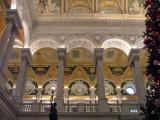
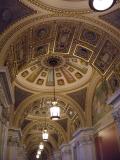
On the first floor of the library are two Bibles: one a Gutenberg Bible (the first book printed with moveable metal type), and the other the Giant Bible of Mainz, which was produced around the same time as the Gutenberg, but was transcribed by hand. Whilst the Gutenberg Bible was a marvel of technology, it was not as beautiful as the hand drawn lettering and decorations of the Mainz.
We visited two exhibits, one on Bob Hope, which included hundreds of scripts, playbills, even an "Bob Hope" doll. There were computers where we watched or listened to many skits from his various shows. There was also an exhibition on the Gershwin brothers and their lives and music - very interesting.
The Library of Congress' main role is to provide information to members of congress, and other activities such as academic and public access is secondary. However, we could have obtained a reader card which would have enabled us to look for books, etc, in their catalog and have them brought out for us to read/listen/watch. Given the copyright act, they even have designs of microchips - anything that is copywritten.
Tuesday 6th January

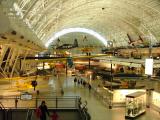
We spent the day at the Smithsonian Air and Space Museum, Steven F. Udvar-Hazy Center, near Washington Dulles Intenational Airport. We caught a coach from outside the Air and Space Museum in the Mall, and arrived before the doors opened (and had to wait in the cold). The Steven F. Udvar-Hazy Center is brand new - opened on December 13th 2003. We were just amazed - so much to see, so many air and spacecraft which are the only ones in any museum anywhere in the world.
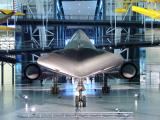
We took a volunteer lead tour which went for nearly 2hours, which took us to most of the unique aircraft, and it was excellent. There was a team of 5 people who took it in turns telling us about aircraft in their area of speciality - military aircraft, or space craft, etc. They knew all manner of fascinating facts about the aircraft, for example, the SR-71 Blackbird which holds the record for flying from Los Angeles to Dulles Airport, which it set on the day of its delivery to the museum, of 1hour and 4minutes. The SR-71 is the fastest air fueled engine aircraft, reaching speeds of over Mach 3, which causes its skin to heat to over 500°F (260°C).
We saw all manner of aircraft and spacecraft, including :
- Space Shuttle Enterprise - never been into space, but was used for testing and training, including being "launched" from the back of its Boing 747 and landing.
| 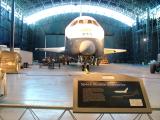
|
- Air France Concorde - the oldest of the Air France fleet of five concordes.
| 
|
- Enola Gay - the aircraft which had the tragic task of dropping the nuclear bomb on Hiroshima, Japan.
| 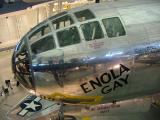
|
- JSF (Joint Strike Fighter) - the newest fighter aircraft being designed by Northrop Grumman and likely to become the next generation fighter for the RAAF. It was astounding to see it, and when we asked how they came to have it, the tour guide said "They phoned us and asked if we'd like it" with a gleam in his eyes.
| 
|
- Gemini and Mercury Capsules
| |
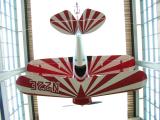
Whilst some aircraft were displayed on the ground, other aircraft were displayed as they might be seen in flight - some as if in dogfights, others, like the S-1C Little Stinker aerobatic aircraft, hanging upside from the ceiling.
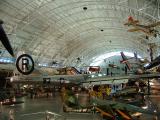
Some interesting things we learnt were that the World War II Japanese aircraft they have on display are mostly the only ones of their type in the world as the peace treaty the USA signed with Japan does not allow the Japanese to show World War II equipment in museums.
We walked our feet off, and were just astounded at all the aircraft.
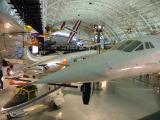
There was a viewing tower which was just like an airport control tower - we took the lift to the viewing area, surrounded with windows, and watched the Dulles runways. We went up early in the morning, but there were not many aircraft arriving or departing. We remembered, however, that there are usually a lot of flights in the later afternoon, so we went up there just before closing and we watched a whole heap of aircraft land and take off right past the tower.
Wednesday 7th January
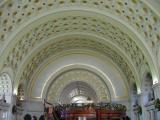
Just like New York City, Washington has a grand train terminal Union Station. It was huge inside - where we entered from the subway there were two level of shops built under the original roof. This shopping area was at one side of the main concourse. The main concorse has a huge curved roof supported by beautiful stonework. We wandered through some stops selling local wood work - the same kind of items we see in Tasmania, except made of some of the unique North American timbers, with their different colours and grains.
Outside the station it was very cold, and whilst Jo went for a look around the National Postal Museum across the road, Rob took photos of the station exterior. There was still thick ice in places on the pavement which made life more exciting.
Unfortunately the FBI museum was closed due to renovations, so we thought we'd have a look around the DEA (Drug Enforcement Administration) Museum. It was in a building across the Potomac River from where we had spent the rest of our time. We had a hard time finding the building and then we picked the wrong entrance. For some reason museum visitors can only use one of the two entrances into the one foyer. We did the usual security thing, and then we were personally welcomed, as if VIPs. We soon discovered why - we were the only visitors there. The museum had a couple of exhibits running : History of Drug use in the USA, Drug Trafficing in the USA and Border Surveillance.
The exhibits steered away from issues such as the wisdom of making some substances illegal, and how this came about. It focused more on the social decay caused by drug use, and the activities of the DEA in trying to stop trafficing. They had a number of items on display which had been confiscated, including a jet ski and dragster.
It seemed that the museum was aimed at teenagers/school groups, and there were interactive multimedia displays on careers in the DEA, for all those budding drug enforcers out there.
We ate lunch in the enclosed shopping mall across the road - it was a lot warmer inside than out.
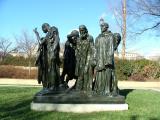
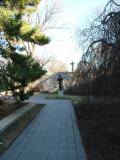
We looked around the sculpture garden outside the
Hirshhorn Museum (another Smithsonian Museum). There were few people there given the weather, but we were rugged up enough (and it was sunny) to take photos. There were some Rodin sculptures (see
San Francisco) as well as a number of other abstract, very abstract, and not so abstract sculptures - SciFi-like spheres, abstract Abraham, a figure passing through a screen.
We went back to the Air and Space Museum in the Mall. We were hoping to see a couple of things in the remaining hours we had left. We saw the Wright Flyer (the first successful airplane!!), the Apollo 11 Command Module (from the first flight to the moon - it was tiny, no room to move and they were there for days), touched some moon rock, saw how huge a Saturn 4 rocket engine was, looked at heaps of other stuff.
The 1:100 scale USS Enterprise model was built by a man over 12 years, taking about 1000 hours for the Enterprise, and another 4000hrs for the 83 aircraft on board.
For dinner we went north of the city to Dupont Circle where there was a Fondue restaurant, "Melting Pot", we had seen advertised. It was getting quite cold and unfortunately we took the wrong exit from the Metro, and had a larger than anticipated walk in the subzero (celcius) temperatures. We were served at a table which had an electric hotplate in the center - amongst a very modern and stylish restaurant.
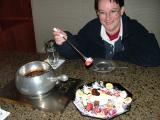
Our waiter was excellent - he had spent some time in Sydney and was friendly and helpful. We were not expecting the range of choice from the types of meat to the liquids the fondue would use. We were keen to try chocolate fondue for desert and were able to swap a cheese appetiser fondue for Chocolate desert fondue - a good swap in our opinion! The waiter was great with what had onion in it. Of course, there was salad to start with - this is America. For main course we had a platter of uncooked meats and vegies, half a dozen dishes of sauces and a pot of stock in which to cook the fondue. There was beef, chicken, salmon, prawns, and heaps of vegies. There was curry, barbeque, ... sauces. We had great fun cooking the food and trying each morsel with a different sauce. Then there was desert - a pot of melted chocolate flavoured with caramel and walnuts, and strawberries, marshmellows, pineapple, banana, yellow cake (no, not uranium), brownies, and a slice of cheesecake! We still had chocolate remaining, so we were given more strawberries to finish off. Very nice!
We were flying back to New York later in the day, and had one last place to visit close to the hotel - the Folger Shakespeare Library. Why there'd be the largest Shakespeare collection in the world in Washington is due to the founders, the Folgers, who were avid collectors of Shakespeares work. Unfortunately the exhibits were closed for renovations when we visited, and we were only able to view a short video and peruse the shop.
Whilst in Washington DC we had 20°C days which caused us to stop wearing out coats and thermals, and then the temperature dropped and some days the forecast was "Maximum in the low 30's", but unlike Adelaide, that was Fahrenheit, and then there was 10-20°F of wind chill, so it was bitterly cold.
We flew out of Washigton back to NYC around lunchtime - a great time to fly as there were few people in the queues for check-in or security.



 The interior is beautiful - no expense spared - more like a palace than a government building. The dome seen from the outside is a different size to the one seen inside - the original was built and painted inside, and the then outside was extended. The tour started in the room below the dome - The Rotunda. In this room, there is a freize depicting the history of the USA - completed by a different artist to the one who started it, due to the original dying partway through the project. The inside of the dome contains a painting called "The Apotheosis of Washington". This painting depicts George Washington surrounded by symbols of American democracy and technological progress.
The interior is beautiful - no expense spared - more like a palace than a government building. The dome seen from the outside is a different size to the one seen inside - the original was built and painted inside, and the then outside was extended. The tour started in the room below the dome - The Rotunda. In this room, there is a freize depicting the history of the USA - completed by a different artist to the one who started it, due to the original dying partway through the project. The inside of the dome contains a painting called "The Apotheosis of Washington". This painting depicts George Washington surrounded by symbols of American democracy and technological progress. The tour continued to the original Hall of the House chamber - this had acoustic problems, as well as seating problems and was not generally liked by those who used it. It has a half-dome roof, which helps in some ways, but as the floor is marble, the echoes were many. This was renamed as the National Statuary Hall, which contains (along with other areas throughout the building) two statues of its notable citizens from each state. Some states have replaced their statues with new ones depending on the people they wish to honour.
The tour continued to the original Hall of the House chamber - this had acoustic problems, as well as seating problems and was not generally liked by those who used it. It has a half-dome roof, which helps in some ways, but as the floor is marble, the echoes were many. This was renamed as the National Statuary Hall, which contains (along with other areas throughout the building) two statues of its notable citizens from each state. Some states have replaced their statues with new ones depending on the people they wish to honour.
 Our guide said we should go across the road to see our state Congress(wo)man to get a ticket to see the House of Representatives where the President gives his annual address. Foreign nationals were instructed to take their passports to somewhere else to get a ticket. As we didn't have passports and have CA drivers licenses but are not citizens, we asked the guide where we shoud go - she pulled tickets from her pocket (she had a wad of them) and gave two to us. So we went and had a look - it was not as meaningful as seeing the House of Reps/Senate Chambers in Canberra - more of a "seen that, next?". They're building a new visitor's center underneath the eastern side of the Capitol Building - they have dug a huge hole in the ground at the front of the building, and construction is due to be completed in 2005. It is costing something like $1 billion which is extraordinary.
Our guide said we should go across the road to see our state Congress(wo)man to get a ticket to see the House of Representatives where the President gives his annual address. Foreign nationals were instructed to take their passports to somewhere else to get a ticket. As we didn't have passports and have CA drivers licenses but are not citizens, we asked the guide where we shoud go - she pulled tickets from her pocket (she had a wad of them) and gave two to us. So we went and had a look - it was not as meaningful as seeing the House of Reps/Senate Chambers in Canberra - more of a "seen that, next?". They're building a new visitor's center underneath the eastern side of the Capitol Building - they have dug a huge hole in the ground at the front of the building, and construction is due to be completed in 2005. It is costing something like $1 billion which is extraordinary. The Library of Congress was started when Thomas Jefferson donated his collection of books to start the library. It has somehow survived fire (where most of the books were burnt) to become the largest library in the world. This is in no small part due to the copyright act which requires all items copywritten to be submitted to the Library of Congress. We arrived in time for a tour, given by a retired lawyer, and he was excellent. He took us all over the building showing us the enormous amount of artwork, mainly on the ceiling! It was all linked, symbolically, to knowledge, the generation and accumulation of it. In the painting there were lots of women dressed to indicate a science or art - the memorable one was the geologist: beautiful Grecian robed woman carrying a Geologist's pick and wearing a Geologist's hat. Names of famous writers, scientists, painters were listed - all on immense story of knowledge. We agreed with the guide that it was the most beautiful building in Washinton
The Library of Congress was started when Thomas Jefferson donated his collection of books to start the library. It has somehow survived fire (where most of the books were burnt) to become the largest library in the world. This is in no small part due to the copyright act which requires all items copywritten to be submitted to the Library of Congress. We arrived in time for a tour, given by a retired lawyer, and he was excellent. He took us all over the building showing us the enormous amount of artwork, mainly on the ceiling! It was all linked, symbolically, to knowledge, the generation and accumulation of it. In the painting there were lots of women dressed to indicate a science or art - the memorable one was the geologist: beautiful Grecian robed woman carrying a Geologist's pick and wearing a Geologist's hat. Names of famous writers, scientists, painters were listed - all on immense story of knowledge. We agreed with the guide that it was the most beautiful building in Washinton


 We spent the day at the Smithsonian Air and Space Museum, Steven F. Udvar-Hazy Center, near Washington Dulles Intenational Airport. We caught a coach from outside the Air and Space Museum in the Mall, and arrived before the doors opened (and had to wait in the cold). The Steven F. Udvar-Hazy Center is brand new - opened on December 13th 2003. We were just amazed - so much to see, so many air and spacecraft which are the only ones in any museum anywhere in the world.
We spent the day at the Smithsonian Air and Space Museum, Steven F. Udvar-Hazy Center, near Washington Dulles Intenational Airport. We caught a coach from outside the Air and Space Museum in the Mall, and arrived before the doors opened (and had to wait in the cold). The Steven F. Udvar-Hazy Center is brand new - opened on December 13th 2003. We were just amazed - so much to see, so many air and spacecraft which are the only ones in any museum anywhere in the world.  We took a volunteer lead tour which went for nearly 2hours, which took us to most of the unique aircraft, and it was excellent. There was a team of 5 people who took it in turns telling us about aircraft in their area of speciality - military aircraft, or space craft, etc. They knew all manner of fascinating facts about the aircraft, for example, the SR-71 Blackbird which holds the record for flying from Los Angeles to Dulles Airport, which it set on the day of its delivery to the museum, of 1hour and 4minutes. The SR-71 is the fastest air fueled engine aircraft, reaching speeds of over Mach 3, which causes its skin to heat to over 500°F (260°C).
We took a volunteer lead tour which went for nearly 2hours, which took us to most of the unique aircraft, and it was excellent. There was a team of 5 people who took it in turns telling us about aircraft in their area of speciality - military aircraft, or space craft, etc. They knew all manner of fascinating facts about the aircraft, for example, the SR-71 Blackbird which holds the record for flying from Los Angeles to Dulles Airport, which it set on the day of its delivery to the museum, of 1hour and 4minutes. The SR-71 is the fastest air fueled engine aircraft, reaching speeds of over Mach 3, which causes its skin to heat to over 500°F (260°C).


 Just like New York City, Washington has a grand train terminal Union Station. It was huge inside - where we entered from the subway there were two level of shops built under the original roof. This shopping area was at one side of the main concourse. The main concorse has a huge curved roof supported by beautiful stonework. We wandered through some stops selling local wood work - the same kind of items we see in Tasmania, except made of some of the unique North American timbers, with their different colours and grains.
Just like New York City, Washington has a grand train terminal Union Station. It was huge inside - where we entered from the subway there were two level of shops built under the original roof. This shopping area was at one side of the main concourse. The main concorse has a huge curved roof supported by beautiful stonework. We wandered through some stops selling local wood work - the same kind of items we see in Tasmania, except made of some of the unique North American timbers, with their different colours and grains.

 Our waiter was excellent - he had spent some time in Sydney and was friendly and helpful. We were not expecting the range of choice from the types of meat to the liquids the fondue would use. We were keen to try chocolate fondue for desert and were able to swap a cheese appetiser fondue for Chocolate desert fondue - a good swap in our opinion! The waiter was great with what had onion in it. Of course, there was salad to start with - this is America. For main course we had a platter of uncooked meats and vegies, half a dozen dishes of sauces and a pot of stock in which to cook the fondue. There was beef, chicken, salmon, prawns, and heaps of vegies. There was curry, barbeque, ... sauces. We had great fun cooking the food and trying each morsel with a different sauce. Then there was desert - a pot of melted chocolate flavoured with caramel and walnuts, and strawberries, marshmellows, pineapple, banana, yellow cake (no, not uranium), brownies, and a slice of cheesecake! We still had chocolate remaining, so we were given more strawberries to finish off. Very nice!
Our waiter was excellent - he had spent some time in Sydney and was friendly and helpful. We were not expecting the range of choice from the types of meat to the liquids the fondue would use. We were keen to try chocolate fondue for desert and were able to swap a cheese appetiser fondue for Chocolate desert fondue - a good swap in our opinion! The waiter was great with what had onion in it. Of course, there was salad to start with - this is America. For main course we had a platter of uncooked meats and vegies, half a dozen dishes of sauces and a pot of stock in which to cook the fondue. There was beef, chicken, salmon, prawns, and heaps of vegies. There was curry, barbeque, ... sauces. We had great fun cooking the food and trying each morsel with a different sauce. Then there was desert - a pot of melted chocolate flavoured with caramel and walnuts, and strawberries, marshmellows, pineapple, banana, yellow cake (no, not uranium), brownies, and a slice of cheesecake! We still had chocolate remaining, so we were given more strawberries to finish off. Very nice!